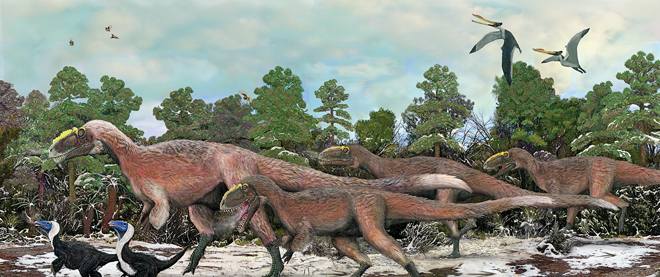New dinosaur discoveries ruffle feathers
Not every expert is happy that one of the big guys was shaggy, not scaly
Illustration of the new giant feathered dinosaur Yutyrannus huali (with 2 smaller Beipiaosaurus). © Brian Choo
Share

Many dinosaur fans picture Tyrannosaurus rex as a massive, scaly, lumbering, upright monster. So, the recent discovery that he had a distant relative with feathers—the newly named Yutyrannus huali, or “beautiful feathered tyrant”—has left some experts disappointed. “Those of us who like our dinosaurs scaly appear to be frowned upon,” paleontologist Mark Wildman wrote on his blog, “as if we ought to rejoice that the dinosaurs are covered in fuzz and feathers. Well, that isn’t going to happen.”
Canadian paleontologist Corwin Sullivan, who was on the team that discovered Y. huali in northeastern China, says it was probably a “shaggy” dinosaur whose feathers provided insulation, “like walking around in a thick fur coat.” (Weighing 1½ tons, Y. huali is 40 times larger than the biggest previously known feathered dinosaur.) “We don’t know what colour they were, which is unfortunate,” Sullivan told Maclean’s from Beijing, where he’s an associate professor at the Institute of Vertebrate Paleontology and Paleoanthropology. “If they were brightly coloured, the feathers might have some role in display or attracting a mate.”
A massive, bright, feathery dinosaur is an exciting thought to some, but to others, it can be jarring. “I’m not that old, but when I grew up, it was all slow, dumb dinosaurs, dragging their tails, outwitted by the clever little mammals,” says Sean Bell, general manager of the T. rex Discovery Centre in Eastend, Sask. “Now, for young people, I don’t think the toys I had as a kid would make sense.” Our understanding of dinosaurs has changed immensely. We now see carnivorous theropod dinosaurs like T. rex as more “active and agile,” Sullivan says. Instead of the “kangaroo-like pose” of the animal rearing up and dragging its tail, they’re depicted more horizontally, with the tail off the ground—for speed.
“Most people prefer the new view of dinosaurs,” Sullivan says, and Bell agrees. But Wildman, who insists he’s not a “feather denier,” hopes that scaly T. rex isn’t next. He writes, “Do you really want the megastars of the dinosaurian world displaying colourful yet gaudy feathers and dancing like a demented turkey cock?”